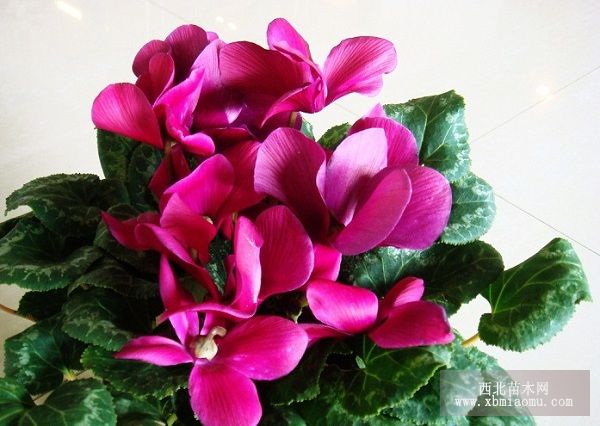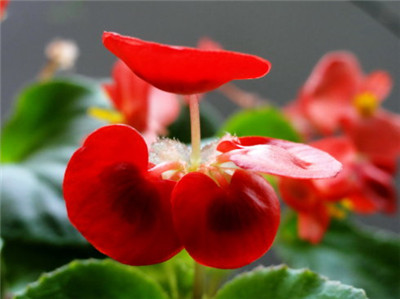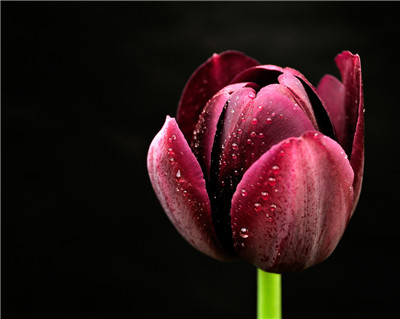Cultivation and management of cyclamen
Cyclamen is a relatively delicate flower species, which is easy to get sick and requires fine maintenance. However, because of its bright and rich flowers, long flowering period, thick leaves and high ornamental value, cyclamen is a good gift for relatives and friends and good wishes. It is also an excellent potted flower placed in living rooms, venues and hotels, and it is still loved by many consumers. When cultivating cyclamen, you should pay attention to the following:
1. Cultivation substrate. Cyclamen peat, perlite and vermiculite were selected as substrates and prepared according to the prescribed proportion.
2. Planting seedlings. In the middle and late ten days of April, when the seedlings in the hole plate grew to 6 to 7 leaves and the root system was filled with the hole plate, the seedlings with strong plants and without disease and insect pests were selected and planted in the pot, and the roots were not harmed. The bulb was exposed 1 cm to 1 cm, and the substrate was 3 cm to 4 cm along the basin, and watered after planting.
3. Water and fertilizer management. Watering should see dry and wet, 1 to 2 days watering, 5 to 7 days to apply cyclamen special fertilizer, thin fertilizer to apply frequently. After autumn, due to the change of natural environment, cyclamen entered a vigorous growth period, the demand for fertilizer and water increased, water and fertilizer management directly affected cyclamen crown width, crown shape, flower bud differentiation, flower shape, flower color and so on. Therefore, attention should be paid to watering and fertilization. the basin soil should be watered in time after drying, and fertilization depends on the growth trend. Cyclamen special fertilizer 15 / 15 / 30 with a concentration of 700ppm to 1000 ppm is applied twice a week. In November, when the flowering period entered one after another, nitrogen fertilizer should be reduced and phosphorus and potassium fertilizer should be increased. In the early stage of flower bud differentiation, 1 part urea and 2 parts potassium hydrogen phosphate were mixed into 1 parts per thousand solution, irrigated once a week, and foliar was sprayed with 1 part potassium chloride and 2 parts potassium hydrogen phosphate solution in about 10 days.

Cyclamen originated in Greece and along the Mediterranean. Sex likes plenty of sunshine and warm, humid environment, avoid hot, afraid of stagnant water. 20 ℃ is its suitable temperature, more than 30 ℃ is easy to deciduous dormancy, and corms below 5 ℃ are easy to suffer frost damage, so it is necessary to grow in greenhouse in winter, requiring loose, fertile and well-drained soil. First, the breeding method is mainly sowing and breeding, and the segmented corm method can also be used for breeding. It is usually suitable for sowing and breeding from early September to mid-October. Sowing too early affects growth, and bulbs blossom when small; too late, the temperature is too low, affecting germination. Because of its large seeds, it is appropriate to soak in water for 24 hours before sowing, and the sowing soil and sowing pot should be disinfected before sowing. Soak the pot after sowing and germinate in the dark place of 20 ℃. Usually it can take root in two weeks and a cotyledon can be produced in six weeks. Second, cultivation and management generally divide seedlings with 3 leaves, transplant and change pots at 6 leaves, and fix pots in September. When transplanting, you should take the whole root, do not shake off the original soil, and the depth of the soil basin should be 1 beat 3 or 1 stick 2 exposed to the soil. Water properly after planting and pay attention to shading. Cyclamen seedlings grow slowly, and the next June will be the peak growth period. During this period, the management of fertilizer and water should be strengthened and liquid fertilizer should be applied twice a month. Topsoil should be watered thoroughly when it is dry, but should not be watered or fertilized on top of leaves and bulbs to prevent decay. The best temperature during the growing period is about 18 ℃. Too high will cause the bulbs to dormancy and hinder the flowering of the year. After October, the temperature drop moves into the room, place in a sunny place, keep the room temperature at 18 ℃, and keep the pot soil moist, but avoid too much humidity, do not apply fertilizer during flowering, so as not to affect the life span of flowers. Third, safe summer cyclamen like cool, humid climate, the temperature above 30 ℃ will enter the dormancy period. The summer climate is hot, if the ventilation is not good, the bulb is easy to rot. Therefore, the annual seedling cyclamen should be placed in a cool, ventilated and sheltered place, and often spray water, sprinkle water, shade and cool, create a cool environment to promote its growth. For more than two-year-old balls, they should be placed in a shady place in summer to keep the basin soil moist and ventilated. After changing pots and replanting in this way, you can sprout leaves quickly, blossom early and blossom more. Cultivation and management techniques of cyclamen
Cyclamen, also known as rabbit ear flower, rabbit flower, radish begonia and so on, is a perennial bulbous flower of Primulaceae. Cyclamen flowers open downward, petals rolled upward, shaped like rabbit ears, hence the name rabbit ear flower. Its bulb is fleshy, flat and round like a radish, so it is also known as radish begonia.
The rhizome of cyclamen is a flat sphere, most of which is not in the soil, only the top part is exposed to the soil, and the bottom is densely bearded. The foliage grows above the bulb, with a long handle, heart-shaped or kidney-shaped, dark green, with obvious white markings and serrulate edges. Flowers large, solitary, pedicel slender, fleshy, petals with five-parted, base connected into a tube. According to the color of the flower, it can be divided into pink, magenta, rose, purple, pink, orange, lilac, red edge and white heart, crimson with spots, white and other varieties, some flowers have fragrance. The petal shape varies with the variety, resembling a monk's hat; some are long and narrow and extend in all directions; some are slightly defective at the edges, or inlaid with folds.
The flowering period of cyclamen is longer, from 1 in the first year to March of the following year, and from late November to late January of the following year. A flower can often bloom undefeated for a month. One-year-old plants can blossom 10 meters and 30 flowers; two-year-old plants can blossom 50 meters and 80 flowers; three-year-old plants can blossom up to 200; old plants more than four years old blossom abnormally.
Cyclamen bears a globose capsule after flowering, and the seeds mature 3 months after flowering. When the fruit turns yellow and soft and the top is slightly cracked, it can be picked. Each flower can bear 40 seeds, and the seeds are dark brown. If the seeds are well preserved, the germination power can be maintained for 3 years.
Cyclamen originated in southern Europe and the Mediterranean, Greece, Tunisia and Syria and other places, for semi-cold bulbous flowers, sex like warm and humid, climate, both afraid of heat, but also afraid of cold. Autumn, winter and spring are the growing season and dormant period, so it is appropriate to put them in a cool and ventilated place, and often spray water around them to cool down, so as not to make the ball dormant, which is beneficial to winter and spring flowering. The optimum growth temperature of cyclamen is 15 ℃ and 20 min, and it needs to be maintained in greenhouse in winter.
Cyclamen is suitable for growing in acidic sandy soil rich in humus. Daily management, we should pay attention to watering should not be too much, often keep the basin soil moist. Do not spray water on the flowers when spraying water to the leaves. If it is too dry, the plant will wear out. Cyclamen prefer fertilizer, but should apply thin fertilizer frequently, generally can be applied once a week, fertilizer and water can not be contaminated on the leaves. When the pedicel is pulled out, bone powder or superphosphate should be applied once more. Fertilization should be stopped and watering should be controlled during flowering.
Doing a good job in the management of cyclamen's summer dormancy period is an important key to raise cyclamen well.
The annual cyclamen is in its seedling stage in the hot summer, and stops growing or grows very slowly when the temperature reaches 30 ℃. After June, the plant should be moved to a shady, ventilated and sheltered place, and water should be sprinkled on the shade and on the ground at noon to reduce the ambient temperature. During this period, it is necessary to stop fertilizing and control watering.
For more than two-year-old plants, it is appropriate to move to an indoor ventilated and cool place for summer. Starting from late May, watering was gradually reduced and fertilization stopped. When the weather is hot, often sprinkle water to the ground to increase environmental humidity, but sprinkle to make the basin soil too wet, just keep it slightly wet. After the weather turned cool in September, the amount of water was slightly increased, and new buds gradually sprouted on the tuber. When the new bud is 3 centimeters high, pour out the old ball, remove the lodging soil, turn the basin, strengthen the management of fertilizer and water, increase the light, in order to sprout and sprout leaves, and blossom one after another during the Spring Festival.
Cyclamen multipurpose sowing method is used in breeding. It is better to sow seeds in late August and mid-October, so that cyclamen seedlings can avoid the hot summer and cold winter. In order to improve the speed of seed germination, the seeds can be soaked in warm water for 3 hours, then wrapped in yarn for 25 ℃ for two days, so that they can sprout half a month after being buried in the soil. Seeds sowed in the basin should not be too thick to cover the soil, half a centimeter to 1 centimeter on the line, cover the mouth of the basin with glass or plastic film, but do not cover the main strict, and then put in the indoor shade, use the soaking pot method to keep the basin soil moist, when the temperature is 18 ℃ and 20 cm, seedlings can emerge in about 1 month. When the seedlings grow 3 true leaves, they should be divided in time. If the seedlings are moved late and the plants are delicate, they will not be able to form bulbs. After the seedlings are put on the pot, you need to put them in a shady place to slow the seedlings so that you can see the sun gradually. Fertilization can be applied once a week after half a month, and the basin soil during the growing period should not avoid high temperature in the scorching sun.
In recent years, some people have successfully propagated with cyclamen leaf cuttings and tuber segmentation. Leaf insertion takes place from March to April or from September to October. When cutting off the leaves, the petiole must take part of the tuber, the larger the tuber, the faster the roots and seedlings. The inserting bed must be ventilated and moisturized, generally using vermiculite as the inserting bed matrix. The propagation of tuber division can be carried out in May after flowering. After the upper part of the tuber was cut off and used as leaf insertion material, the lower bulb remained in the soil, and then cut into a square of 1 cm with a depth of 1 cm on the section. Adventitious buds will be produced on the section soon, and the tubers with new buds will be divided and transplanted after 3-Mel for 4 months. It is said that using these two methods to raise seedlings is faster than sowing, blossoms earlier, and can maintain the characteristics of good and good products.
The main diseases of cyclamen are Botrytis cinerea, anthrax, bacterial soft rot, root-knot nematode, cyst nematode and so on.
Botrytis cinerea: occurs on leaves, petioles and flowers of cyclamen. At the beginning of the disease, small dark green white spots appeared on the leaves, showing flooded markings, and then gradually spread to the whole leaf, resulting in the death of the dry surface of the leaf. After the petiole and pedicel are damaged, there will be water-immersed rot and gray mildew spots. During the onset of the disease, 70% topiramate 1000ml 1500 times or 1% equivalent Bordeaux solution can be sprayed once every half a month for prevention and treatment.
Anthracnose: mostly occurs on the back of cyclamen leaves, initially a small brown spot, the disease spot is filamentous, nearly round or irregular, and black-gray particles will appear on the disease spot in the later stage. After the infected leaves are found, the diseased leaves should be cut off and destroyed in time. You can also use 60% anthrax Fumei 800m 1000 times solution, or use 50% carbendazim wettable powder 500ml 600 times solution, spray once a week for prevention and control, usually 2 Mel 3 times can be effective.
Bacterial soft rot: it mostly occurs on the petiole and corm of cyclamen. At the initial stage, it shows water-immersion softening, leaf green decline, white or dark gray-green disease spot, soft rot, expansion, rupture, epidermis shedding, and smelly after expansion. After the corm is infected, it will become black, soft and rotten, showing a paste. The method of prevention and control is to strengthen ventilation, pay attention to drainage and shelter from rain. 200-1000ppm streptomycin or oxytetracycline or penicillin solution can also be used to spray and smear the diseased plants. 700 times of dimethazone solution irrigated the diseased rhizosphere soil.
Root-knot nematode disease: caused by root-knot nematode parasitic cyclamen root, the stimulation of nematode secretion makes the root tissue hypertrophy and proliferation, forming many nodules, thus destroying the normal function of the root, resulting in weakening growth and even death. The original solution of dichlorvos mixture can be used to fumigate the soil, disinfect the soil and wait for 2 weeks before sowing or transplanting. It can also be buried in the basin 15ml 50 grams of 3% furan fruit for prevention and control.
Cyst nematode: after invading the roots of seedlings, many galls of different sizes are formed. in severe cases, the fine roots become rotten and the leaves turn yellow and die. The method of controlling root-knot nematode can be used.
- Prev

How to raise four seasons begonia in summer
Begonia is the most common and cultivated species of begonia. The four seasons crabapple has beautiful posture, bright green leaves, clusters of flowers, gorgeous and dignified flowers, more delicate against the green leaves, it is a good ornamental plant, and the flowers are open all the year round, with a slight fragrance, used to decorate the room.
- Next

Some Experiences in Tulip Cultivation
Tulip flower beautiful, beautiful plant type is a common ornamental plants, this year, into the fresh cut flower market popular, and tulip pedicel long and elegant, is a good flower arrangement materials. Tulip market prospects are broad, cultivation should pay attention to the following
Related
- Fuxing push coffee new agricultural production and marketing class: lack of small-scale processing plants
- Jujube rice field leisure farm deep ploughing Yilan for five years to create a space for organic food and play
- Nongyu Farm-A trial of organic papaya for brave women with advanced technology
- Four points for attention in the prevention and control of diseases and insect pests of edible fungi
- How to add nutrient solution to Edible Fungi
- Is there any good way to control edible fungus mites?
- Open Inoculation Technology of Edible Fungi
- Is there any clever way to use fertilizer for edible fungus in winter?
- What agents are used to kill the pathogens of edible fungi in the mushroom shed?
- Rapid drying of Edible Fungi

